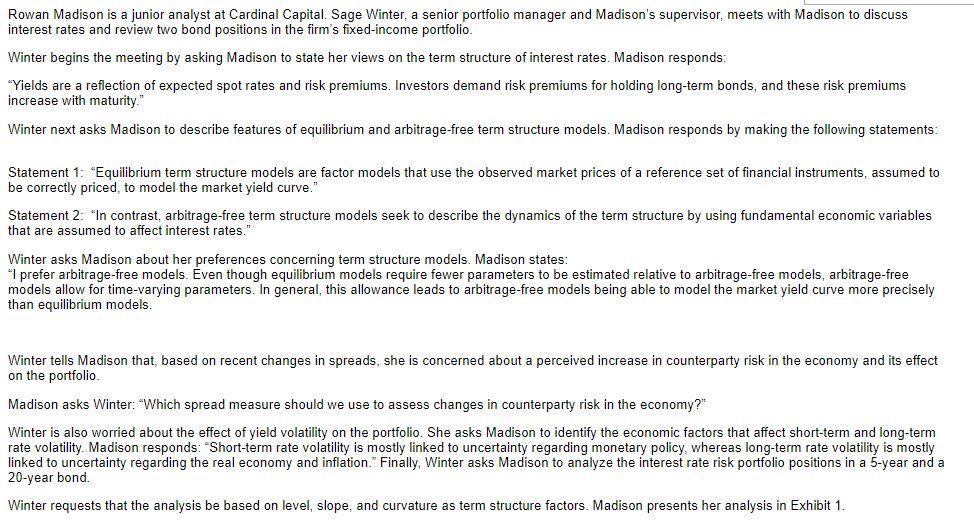I see someone answered multiple choice questions can you please help me with the calculations

Rowan Madison is a junior analyst at Cardinal Capital. Sage Winter, a senior portfolio manager and Madison's supervisor, meets with Madison to discuss interest rates and review two bond positions in the firm's fixed-income portfolio. Winter begins the meeting by asking Madison to state her views on the term structure of interest rates. Madison responds: "Yields are a reflection of expected spot rates and risk premiums. Investors demand risk premiums for holding long-term bonds, and these risk premiums increase with maturity." Winter next asks Madison to describe features of equilibrium and arbitrage-free term structure models. Madison responds by making the following statements: Statement 1. "Equilibrium term structure models are factor models that use the observed market prices of a reference set of financial instruments, assumed to be correctly priced, to model the market yield curve." Statement 2: "In contrast, arbitrage-free term structure models seek to describe the dynamics of the term structure by using fundamental economic variables that are assumed to affect interest rates." Winter asks Madison about her preferences concerning term structure models. Madison states: "I prefer arbitrage-free models. Even though equilibrium models require fewer parameters to be estimated relative to arbitrage-free models, arbitrage-free models allow for time-varying parameters. In general, this allowance leads to arbitrage-free models being able to model the market yield curve more precisely than equilibrium models. Winter tells Madison that, based on recent changes in spreads, she is concerned about a perceived increase in counterparty risk in the economy and its effect on the portfolio. Madison asks Winter: "Which spread measure should we use to assess changes in counterparty risk in the economy?" Winter is also worried about the effect of yield volatility on the portfolio. She asks Madison to identify the economic factors that affect short-term and long-term rate volatility. Madison responds: "Short-term rate volatility is mostly linked to uncertainty regarding monetary policy, whereas long-term rate volility is mostly linked to uncertainty regarding the real economy and inflation." Finally, Winter asks Madison to analyze the interest rate risk portfolio positions in a 5 -year and a 20 -year bond. Winter requests that the analysis be based on level, slope, and curvature as term structure factors. Madison presents her analysis in Exhibit 1. Rowan Madison is a junior analyst at Cardinal Capital. Sage Winter, a senior portfolio manager and Madison's supervisor, meets with Madison to discuss interest rates and review two bond positions in the firm's fixed-income portfolio. Winter begins the meeting by asking Madison to state her views on the term structure of interest rates. Madison responds: "Yields are a reflection of expected spot rates and risk premiums. Investors demand risk premiums for holding long-term bonds, and these risk premiums increase with maturity." Winter next asks Madison to describe features of equilibrium and arbitrage-free term structure models. Madison responds by making the following statements: Statement 1. "Equilibrium term structure models are factor models that use the observed market prices of a reference set of financial instruments, assumed to be correctly priced, to model the market yield curve." Statement 2: "In contrast, arbitrage-free term structure models seek to describe the dynamics of the term structure by using fundamental economic variables that are assumed to affect interest rates." Winter asks Madison about her preferences concerning term structure models. Madison states: "I prefer arbitrage-free models. Even though equilibrium models require fewer parameters to be estimated relative to arbitrage-free models, arbitrage-free models allow for time-varying parameters. In general, this allowance leads to arbitrage-free models being able to model the market yield curve more precisely than equilibrium models. Winter tells Madison that, based on recent changes in spreads, she is concerned about a perceived increase in counterparty risk in the economy and its effect on the portfolio. Madison asks Winter: "Which spread measure should we use to assess changes in counterparty risk in the economy?" Winter is also worried about the effect of yield volatility on the portfolio. She asks Madison to identify the economic factors that affect short-term and long-term rate volatility. Madison responds: "Short-term rate volatility is mostly linked to uncertainty regarding monetary policy, whereas long-term rate volility is mostly linked to uncertainty regarding the real economy and inflation." Finally, Winter asks Madison to analyze the interest rate risk portfolio positions in a 5 -year and a 20 -year bond. Winter requests that the analysis be based on level, slope, and curvature as term structure factors. Madison presents her analysis in Exhibit 1







